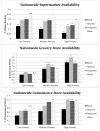The intersection of neighborhood racial segregation, poverty, and urbanicity and its impact on food store availability in the United States
- PMID: 24161713
- PMCID: PMC3970577
- DOI: 10.1016/j.ypmed.2013.10.010
The intersection of neighborhood racial segregation, poverty, and urbanicity and its impact on food store availability in the United States
Abstract
Background: Food store availability may determine the quality of food consumed by residents. Neighborhood racial residential segregation, poverty, and urbanicity independently affect food store availability, but the interactions among them have not been studied.
Purpose: To examine availability of supermarkets, grocery stores, and convenience stores in US census tracts according to neighborhood racial/ethnic composition, poverty, and urbanicity.
Methods: Data from 2000 US Census and 2001 InfoUSA food store data were combined and multivariate negative binomial regression models employed.
Results: As neighborhood poverty increased, supermarket availability decreased and grocery and convenience stores increased, regardless of race/ethnicity. At equal levels of poverty, Black census tracts had the fewest supermarkets, White tracts had the most, and integrated tracts were intermediate. Hispanic census tracts had the most grocery stores at all levels of poverty. In rural census tracts, neither racial composition nor level of poverty predicted supermarket availability.
Conclusions: Neighborhood racial composition and neighborhood poverty are independently associated with food store availability. Poor predominantly Black neighborhoods face a double jeopardy with the most limited access to quality food and should be prioritized for interventions. These associations are not seen in rural areas which suggest that interventions should not be universal but developed locally.
Keywords: Concentrated poverty; Food store availability; Health disparity; Neighborhood; Racial residential segregation.
© 2013.
Conflict of interest statement
The authors declare that they have no conflicts of interest.
Figures


Similar articles
-
Food store availability and neighborhood characteristics in the United States.Prev Med. 2007 Mar;44(3):189-95. doi: 10.1016/j.ypmed.2006.08.008. Epub 2006 Sep 25. Prev Med. 2007. PMID: 16997358
-
Impact of Neighborhood Sociodemographic Characteristics on Food Store Accessibility in the United States Based on the 2020 US Census Data.Dela J Public Health. 2022 Aug 31;8(3):94-101. doi: 10.32481/djph.2022.08.016. eCollection 2022 Aug. Dela J Public Health. 2022. PMID: 36177172 Free PMC article.
-
Association between neighborhood need and spatial access to food stores and fast food restaurants in neighborhoods of colonias.Int J Health Geogr. 2009 Feb 16;8:9. doi: 10.1186/1476-072X-8-9. Int J Health Geogr. 2009. PMID: 19220879 Free PMC article.
-
Structural racism and geographic access to food retailers in the United States: A scoping review.Health Place. 2023 Sep;83:103089. doi: 10.1016/j.healthplace.2023.103089. Epub 2023 Aug 7. Health Place. 2023. PMID: 37557002
-
An Examination of Failed Grocery Store Interventions in Former Food Deserts.Health Educ Behav. 2019 Oct;46(5):749-754. doi: 10.1177/1090198119853009. Epub 2019 Jun 19. Health Educ Behav. 2019. PMID: 31216883 Review.
Cited by
-
Interplay of race and neighborhood deprivation on resting and ambulatory blood pressure in young adults.Am J Physiol Heart Circ Physiol. 2024 Sep 1;327(3):H601-H613. doi: 10.1152/ajpheart.00726.2023. Epub 2024 Jul 12. Am J Physiol Heart Circ Physiol. 2024. PMID: 38995211
-
Physician-Chef-Dietitian Partnerships for Evidence-Based Dietary Approaches to Tackling Chronic Disease: The Case for Culinary Medicine in Teaching Kitchens.J Healthc Leadersh. 2023 Jul 24;15:129-137. doi: 10.2147/JHL.S389429. eCollection 2023. J Healthc Leadersh. 2023. PMID: 37520178 Free PMC article. Review.
-
The Unequal Effect of Income on Risk of Overweight/Obesity of Whites and Blacks with Knee Osteoarthritis: the Osteoarthritis Initiative.J Racial Ethn Health Disparities. 2020 Aug;7(4):776-784. doi: 10.1007/s40615-020-00719-5. Epub 2020 Feb 21. J Racial Ethn Health Disparities. 2020. PMID: 32086795 Free PMC article.
-
Comparison of Breast Cancer Molecular Features and Survival by African and European Ancestry in The Cancer Genome Atlas.JAMA Oncol. 2017 Dec 1;3(12):1654-1662. doi: 10.1001/jamaoncol.2017.0595. JAMA Oncol. 2017. PMID: 28472234 Free PMC article.
-
Behavioral Patterns of Sugary Drink Consumption among African American Adolescents: A Pilot and Feasibility Study Using Ecological Momentary Assessment.Nutrients. 2023 May 2;15(9):2171. doi: 10.3390/nu15092171. Nutrients. 2023. PMID: 37432343 Free PMC article.
References
-
- Acevedo-Garcia D. Residential segregation and the epidemiology of infectious diseases. Social Science & Medicine. 2000;51:1143–1161. - PubMed
-
- Baltimore City Health Department. [Accessed April 28, 2012];Baltimarket: The Virtual Supermarket Project. [Online]. Available: http://www.baltimorehealth.org/virtualsupermarket.html.
-
- Black JL, Macinko J. Neighborhoods and obesity. Nutrition Reviews. 2008;66:2–20. - PubMed
Publication types
MeSH terms
Grants and funding
LinkOut - more resources
Full Text Sources
Other Literature Sources
Research Materials

